Pacman frog is a unique and exotic pet that more and more people are trying to get their hands on them. So it’s not a far-fetched idea that you’re also considering adding one of these fascinating creatures to your family. However, to accomplish that, it’s important to set up their habitat correctly.
Pacman frog habitats are fun and rewarding to set up for your pet. Properly preparing their home will help ensure that your little amphibian friend is happy and healthy.
In this guide, I will go over everything you need to know to get your new pet set up in his or her new home. From choosing the right tank size to figuring out what type of substrate to use, I’ve got you covered. So read on and learn how to make your Pacman frog’s habitat perfect!
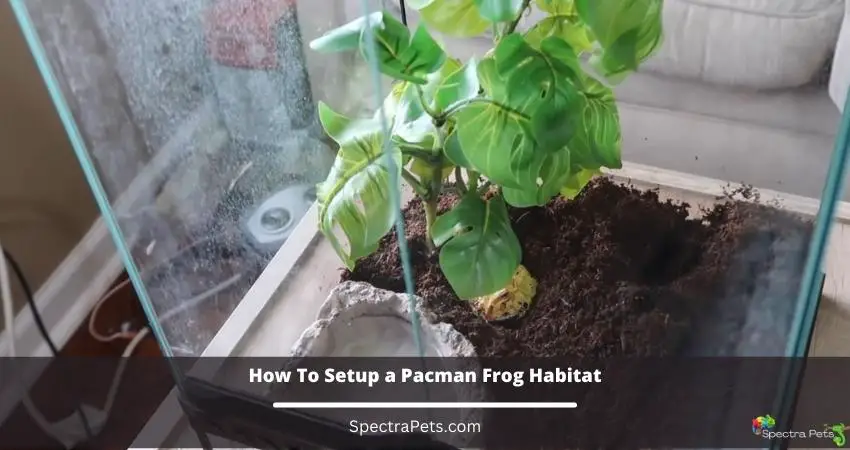
Setting Up a Perfect Pacman Frog Habitat in 12 Simple Steps
Setting up a habitat for your pet Pacman frog is an important and exciting task. A Pacman frog’s home should be escape-proof, safe, and comfortable so that your frog can live a happy and healthy life.
Let’s take a look at how to set up the perfect Pacman frog habitat step-by-step.
1) Choose the right size tank
A 10-gallon tank is sufficient for one adult Pacman frog. If you plan on keeping more than one frog, you will need a larger tank.
Remember, Male Pacman frogs can grow up to 4 inches and females can grow up to 8 inches. Read more about Pacman Frog size.
So, if the tank size is less than 10-gallon, it can create problems for your frog to live comfortably.
2) Pick the right type of tank
There are usually two types of tanks available for frogs. Glass tanks and Plastic tanks. Frog tanks made of plastic are lightweight, easy to handle, and less expensive than glass ones.
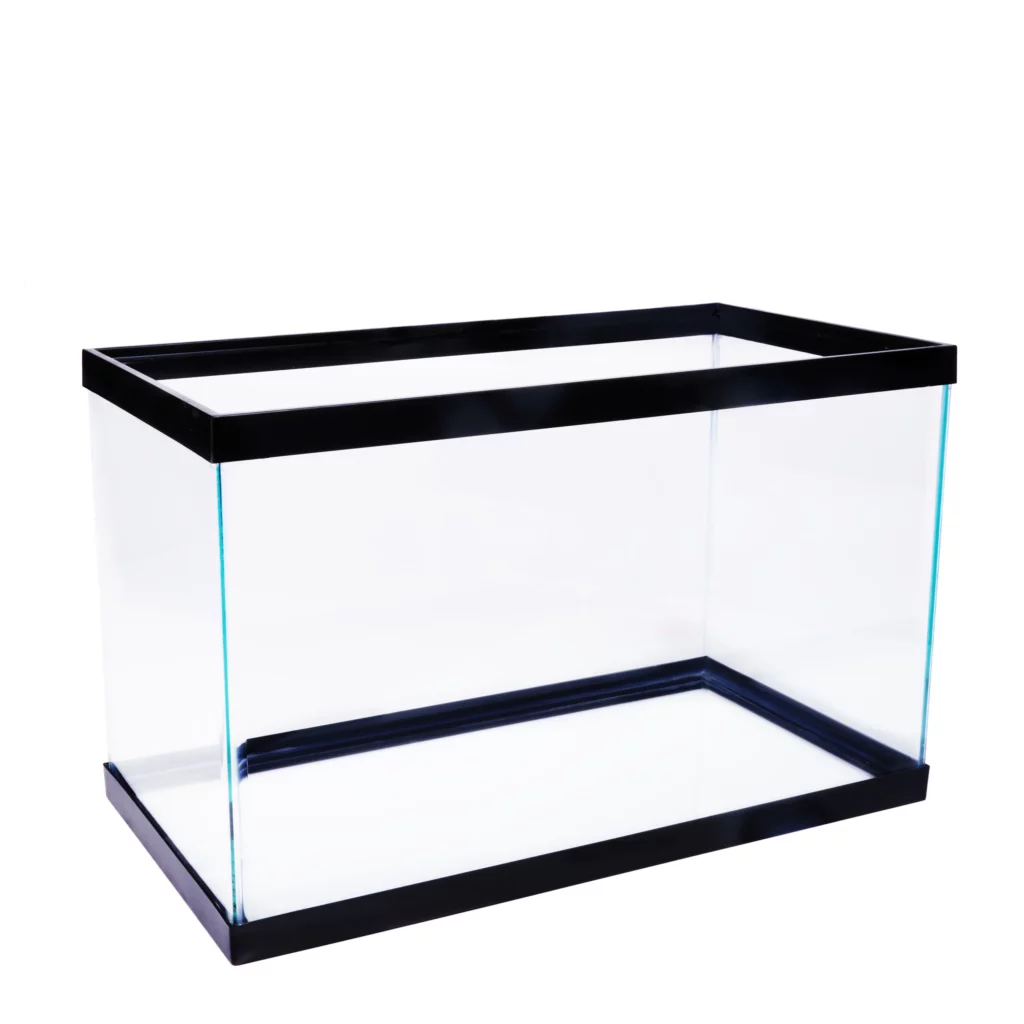
It is important to remember, however, that if you choose to use a plastic tank, you should ensure that it is sturdy enough to support the weight of other stuff you are going to put in and is made of high-quality materials.
On the other hand, glass tanks give a premium look, provide a realistic appearance, and are more stable and durable than plastic tanks. Moreover, you can easily keep an eye on your frog as it is transparent.
But, glass tanks are heavyweight, breakable, and a bit more expensive than plastic tanks. So, it’s all up to you whether you want a more durable or lighter option.
Just make sure the tank is resistant to humidity, made of non-toxic materials, and isn’t breakable.
3) Clean and place the tank in the right location
After you have chosen and bought the tank, it’s time to clean it. Before adding your frog to the tank, you need to clean it with a clean cloth and distilled water. Don’t use any harmful chemical cleaners as they can be toxic for your frog.
After cleaning the tank, place it in a quiet location of your house away from any direct sunlight or drafts. Make sure that you place the terrarium well beyond the reach of any small children or pets in your home.
4) Place a heater under the tank
While these frogs are relatively low-maintenance animals, there are still a few key things you will need to provide. One of those things is an under-tank heater. This will help to create a warm, humid environment that is essential for your frog’s health.
When choosing an under-tank heater, be sure to select one that is specifically designed for reptile habitats. This will help to ensure that it does not get too hot and does not create any safety hazards.
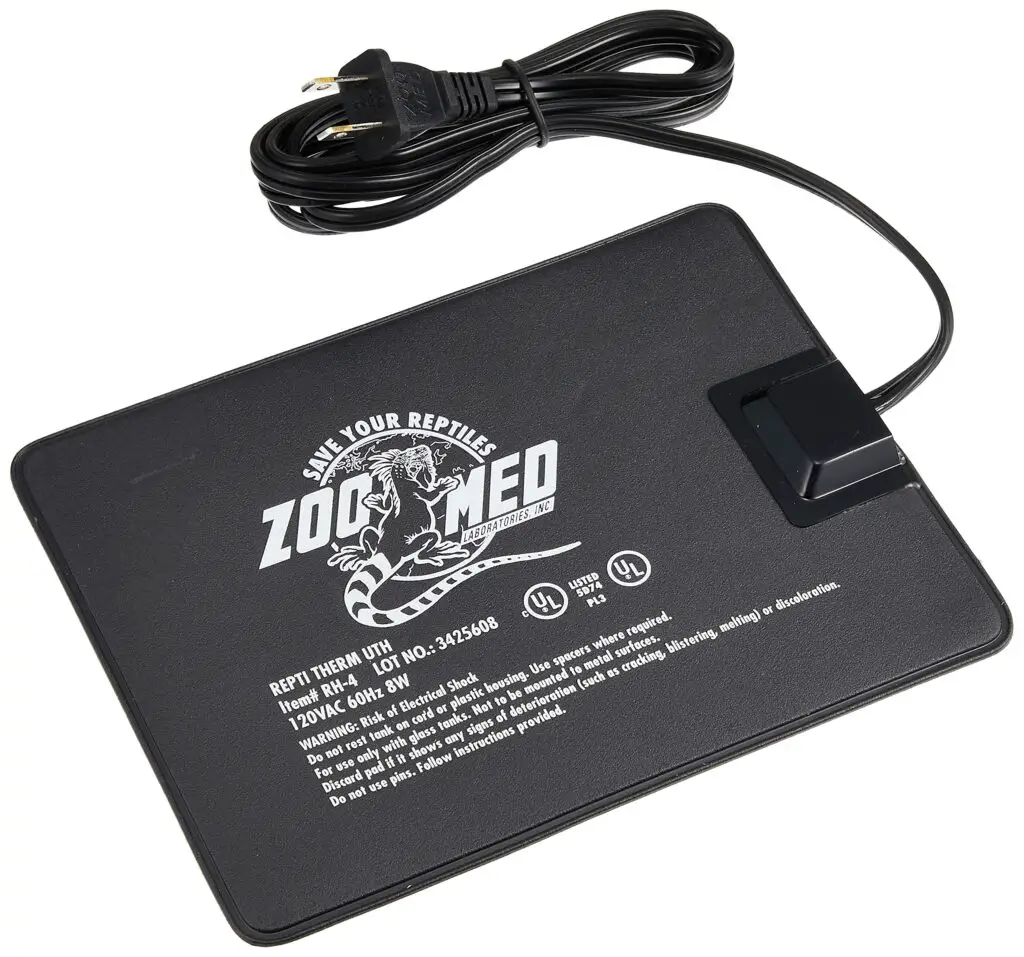
Once you have your under tank heater in place, you can then begin to add other items to your frog’s habitat, such as plants and hiding places.
Remember, the ideal temperature for Pacman frogs is 75-80 degrees Fahrenheit. So, you have to make sure that the temperature never drops below 70 degrees or goes above 85 degrees.
5) Adding the right substrate
The substrate is the material that you put at the bottom of the tank where your frog will sit, walk, and sleep. There are many different types of substrates available in the market.
I have researched and written an article on the best substrate for Pacman frogs, which you can read here.
After getting the substrate, it’s time to add it to the tank. As Pacman frogs love to burrow and remain hidden, you need to add at least 3–4 inches of the substrate to the bottom of the tank. This will give your frog plenty of space to burrow and hide.
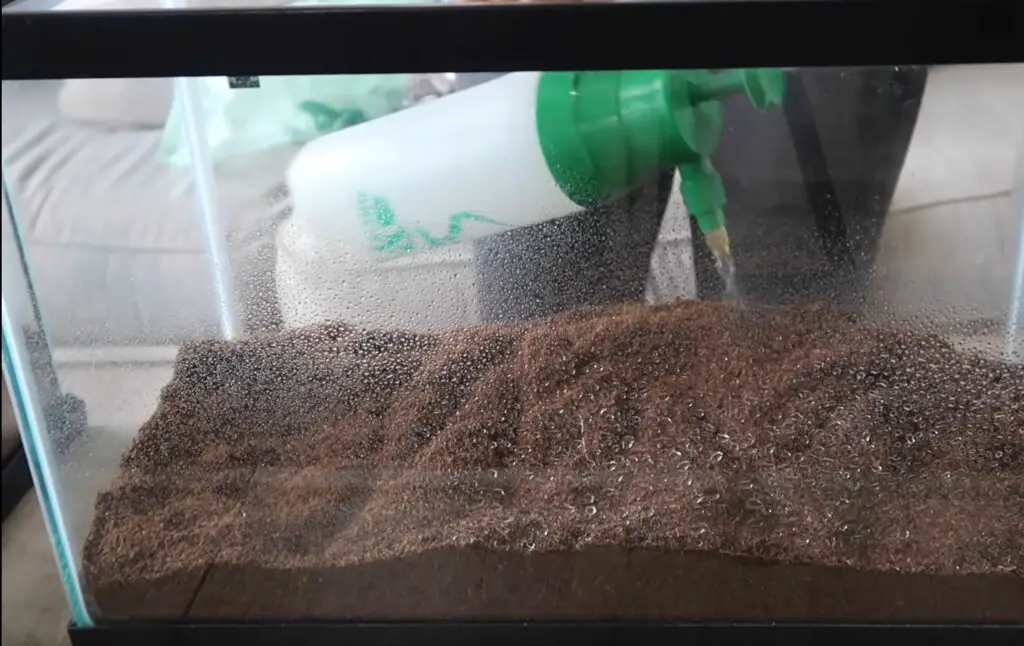
While adding substrate, don’t forget to provide some hiding spots as Pacman frogs love to play hide and seek. You can use logs, rocks, or anything that you think will make a good hiding spot for your frog without harming them.
Another thing I want to emphasize here is that, try to avoid using sand as a substrate as it can be harmful to your frog. Also, Pacman can eat anything that will fit in their mouth, so don’t put any low-quality substrate in the tank which your frog might ingest and get sick.
6) Adding plants and décor
Now that you have added the substrate, it’s time to add some plants and décor to the tank. These decorative things will help your frog to adjust the environment and will also make the habitat look more natural and beautiful.
When adding plants to the terrarium, be sure to use only those plants that have been specifically labeled as safe for reptiles. This is important as some plants can be poisonous if ingested.
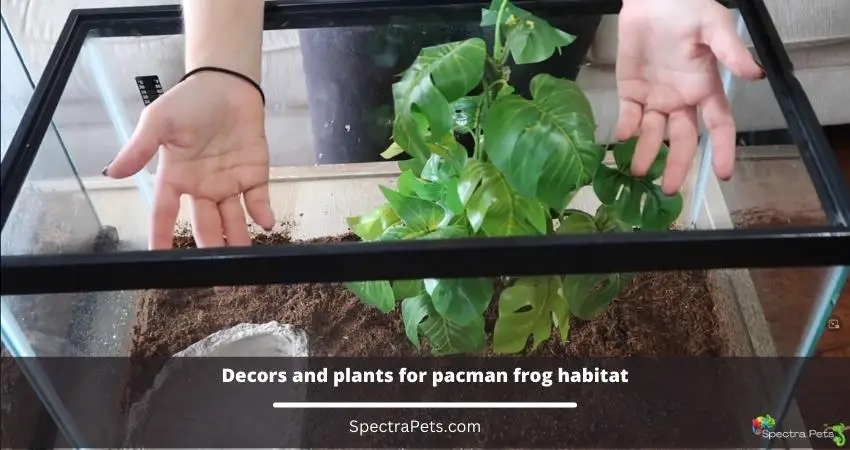
As for décor, you can use anything that you think will look good in the tank and won’t harm your frog. Some ideas include rocks, logs, or even driftwood. Just be sure that any items you use are safe for reptiles and can’t be ingested by your frog.
You can also add a rainforest background image to the back of the tank, which will make it look more natural and beautiful. Your frog will feel more relaxed in such an environment.
7) Adding the water feature
Now it’s time to add a water area to the tank. This is an important step as Pacman frogs need to have a place to bathe and drink. Also, Pacman frogs need to have a water source in order to stay hydrated.
So, when adding a water area, you can either use a small bowl or dish that is specifically designed for reptiles. Be sure to clean this regularly and change the water often to keep it fresh. Also, don’t put any chlorinated water in the bowl as it can be harmful to your frog.
So, don’t use tap water, instead use filtered or distilled water.
Your frog’s water area doesn’t need to be very big. Just make sure it’s large enough for your frog to comfortably bathe in after shedding its skin.
8) Place the Hygrometer, Thermostat, and Thermometer
Pacman frogs are native to humid tropical climates, so they require high humidity levels and warm temperatures.
A hygrometer can help you to monitor the humidity level in the habitat, and a thermometer will allow you to keep an eye on the temperature.
It’s also a good idea to use a thermostat to maintain consistent conditions.
You can place the hygrometer in the center of the habitat. Then, place the thermostat outside the tank and the thermometer on the inner side of the terrarium. Next, turn on the thermostat and adjust it until it reaches the desired temperature. Also, ensure that the humidity level is around 70-80%.
9) Adding a UVB light to the enclosure
All amphibians, including the Pacman frog, require a special type of lighting in their habitat called UVB lighting. This kind of lighting is necessary for helping the amphibians process vitamins which are important for their growth and health. Without it, your pet could become sick or even die.
Also, UVB light helps your frog absorb calcium, which is necessary for healthy bones and muscles.
Most importantly, this lighting will help your Pacman frogs feel the difference between day and night. So, they can know when it’s time to sleep and when it’s time to be active.
You just need to make sure that this fluorescent light is turned on 12 hours per day and turned off at night.
The good news is that setting up UVB lighting for your Pacman frog’s habitat is not difficult.
First, you will need to purchase a UVB light designed specifically for reptiles and amphibians. These can be found at most pet stores.
Once you have the light, simply install it over the habitat according to the instructions that come with it. Be sure to position the light properly so that your frog will be able to bask in its rays, but not so close that it will be too hot.
However, If you want to raise Albino Pacman frogs, you shouldn’t use any UVB lighting as it can be harmful to the frog.
10) Misting The Tank Properly
Pacman frogs come from humid environments, so it’s important to maintain high humidity levels in their habitat. So, misting the air inside your frog’s habitat is essential to prevent its skin from drying out and becoming irritated.
The best way to do this is to mist the enclosure with a water bottle at least 2 times a day. You should mist everything inside the habitat, and it might take up to 10 minutes. So, be patient, and don’t forget to use distilled water or filtered water so that you don’t inadvertently harm your frog.
When misting, be sure to avoid getting water on your frog directly, as this can cause it to stress. Water droplets on their skin can also lead to fungal infections.
11) Putting the Pacman Frog into Its New Home
After you have completed all the steps above, your Pacman frog’s habitat is now ready for its new occupant! When adding your frog to its enclosure, be sure to do so gently and slowly.
Also, try to keep disturbance to a minimum so that your frog doesn’t get too stressed out.
It’s also a good idea to place your frog in its habitat at night, as this is when they are most active. Once your frog is in its new home, give it a few days to adjust, and it will start living its best life.
12. Adding the Screen lid
The final step is to add a screen lid to the top of the habitat. This is important for two reasons.
- First, it will help to maintain proper humidity levels inside the enclosure.
- Second, it will prevent your frog from being attacked by your cats, dogs, or other predators. When choosing a screen lid, be sure to get one that fits snugly on top of the tank.
To add the screen lid, simply place it on top of the habitat and secure it in place with clips or tape. Be sure to leave a small opening for ventilation.
And that’s it! Your Pacman frog habitat is now complete.
Pacman frog’s Habitat maintaining Tips
After setting up the habitat, you need to maintain it regularly to keep your Pacman frog healthy and happy. Here are some tips on how to do that:
1) Check the humidity level regularly
One of the most important things you need to do to care for your Pacman frog is to monitor the humidity levels inside its habitat. As we mentioned earlier, these frogs come from humid environments and require high humidity levels to stay healthy.
If the levels get too low (below 70%), simply mist the air inside the habitat with a water bottle.
2) Keep the habitat clean
Another important thing to do is to keep your Pacman frog’s habitat clean. These frogs are messy eaters and their waste can quickly build up inside the enclosure. So, it’s important to remove their waste regularly and clean the entire habitat at least once a week.
To clean the habitat, simply remove everything from inside the tank and wash it properly.
3) Change the substrate regularly
Another thing you need to do is to change the substrate inside the habitat regularly. This is because Pacman frogs often burrow, and their waste can contaminate the substrate. So, it’s important to remove the old substrate and replace it with the fresh substrate after certain periods.
Last words
Pacman frogs are a great pet for those who are looking for something a little different. It is relatively easy to care for these unique amphibians, but you must make sure their habitat is suitable for them.
I’ve given you a thorough outline of how to set up a Pacman frog habitat. Just by following it properly, you will be able to build the right habitat for your Pacman frog to keep it healthy and happy for a long time. Thanks for reading.

